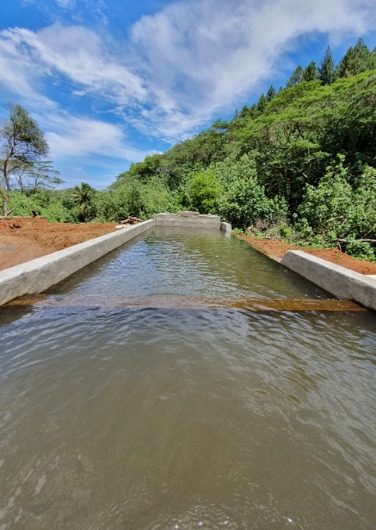Cook Islands celebrates World Water Day despite ongoing shortages
Friday 22 March 2024 | Written by Melina Etches | Published in Environment, Local, National

Water intake in Tamarua, Mangaia. ICI/24032114
Cook Islands joins the world in celebrating World Water Day today, despite recent challenges with water shortages in homes, especially those living in the Pa Enua.
The World Water Day held annually on March 22, focuses on the importance of fresh water that billions across the globe depend on.
In the Cook Islands, infrequent rainfall leads to a very low water supply, often resulting in drought conditions.
Late last year, Aitutaki residents complained about
the ongoing water shortage crisis on the island, as some households faced
extended periods of water cuts lasting up to four weeks and more.
The island acquires its water supply from groundwater galleries and from roof
runoffs collected in rainwater tanks to support its 1782 residents. These
groundwater galleries are located in the villages of Tautu, Vaiamaru, Vaipae,
Vaitaparoro, Vatekea and three in Vaipeka. The gallery in Vaitaparoro was
constructed in 2019. It was constructed using Ecoblocks – an engineering
solution that absorbs and stores water from the ground before it is released
into the distribution network.
Otheniel Tangianau, senior manager Pa Enua Special Projects at Te Tango Angaanga o te Kuki Airani/Infrastructure Cook Islands (ICI), said yesterday that all the pump stations were working on Aitutaki except for the Vaipeka N0 3 pump station.
Tangianau explained that the Aitutaki Island Government is currently acquiring the necessary fittings to install the existing pump on the island and get it operational.
“At present the water system on Aitutaki is okay,” Tangianau said.
The Aitutaki Island Government together with ICI have nearly completed the installation of 230 x 6000 litre polyethylene (PE) tanks on the island, following the installation of 309 x 6000l PE tanks in 2016.
“This should allow all households on Aitutaki to have 1 x PE tank per occupied household procured by the Government. This is the same for all 11 islands in the Pa Enua,” Tangianau said.
Around 540 6000-litre household water tanks and eight community tanks will collect roof water runoff, subsidising Aitutaki’s groundwater supply.
The ground and community tank water are distributed to the villages via a UPVC pipe network, five overhead tanks and eight pump stations. The pumps manage the extraction of groundwater.
In Aitutaki, groundwater has been harvested over decades however the recharge of the groundwater has not matched its harvesting therefore this water source is under stress.
Mangaia catches its water supply from its streams. Household and community rainwater tanks also provide ultraviolet treated drinking water for its community of 471 people.
The water from the streams in Tamarua, Oneroa and Ivirua are collected into intakes and distributed through three separate village-based water distribution networks made up of UPVC pipes, two overhead tanks and two pumping systems.
In the northern group islands, the three atolls of Manihiki, Rakahanga and Penrhyn rely on community and household tanks to capture the rainfall from roofs.
These islands do have groundwater wells but with the water tank systems now in place, the use of these wells has significantly reduced.
Manihiki supplies water for its 215 residents through a combination of sources. This includes 28 concrete community and institutional tanks with a capacity of 45,000 litres each, and standard 6000-litre plastic tanks for individual homes.
Rakahanga has a population of 81 people. Its water supply is captured by 12 45,000 litre concrete community and institutional tanks and 72 household tanks.
Penrhyn has tanks that supply water for its 233 people. These tanks are a combination of mainly concrete tanks ranging between 45,000 and 97,000-litre capacity and some 25,000 litre plastic community tanks, as well as 140 household tanks.
Several of the 25000 litre plastic tanks were shipped from Rarotonga to Penrhyn full of water in 2018/19 and 2020 during a drought.
In recent years these concrete tanks have been successfully retrofitted to increase their capacity.
According to ICI, desalination comes at a very high cost and “at this time desalination is not a viable option for the Cook Islands”.
ICI recognises that storage is needed to capture as much rainfall as well as to practice water conservation for drought periods.
- Additional reporting ICI




















































